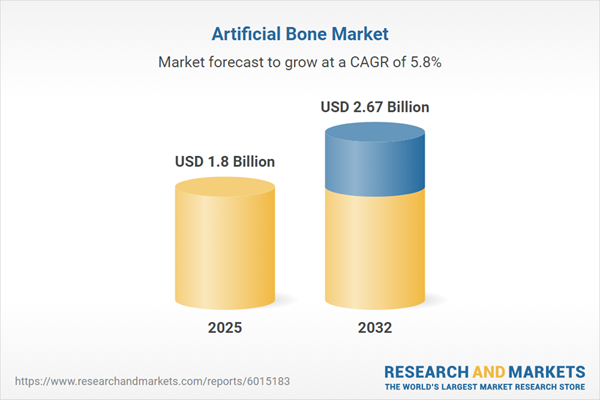Speak directly to the analyst to clarify any post sales queries you may have.
The artificial bone market is undergoing significant transformation, shaped by advances in regenerative medicine, evolving regulatory landscapes, and dynamic global supply chain factors. Senior leaders must understand how technological innovation, tariffs, and strategic alliances are influencing procurement and development across regions.
Market Snapshot: Artificial Bone Market Growth and Trends
The Artificial Bone Market grew from USD 1.70 billion in 2024 to USD 1.80 billion in 2025. With a projected CAGR of 5.77%, the market is on track to reach USD 2.67 billion by 2032. This upward trajectory is driven by the aging population, increased rates of traumatic injury, and a pursuit of advanced surgical and regenerative solutions. The integration of sophisticated biomaterial science and digital engineering is enabling providers to achieve enhanced patient outcomes and reducing operative risks, propelling market momentum.
Scope & Segmentation Analysis
This research analyzes the artificial bone sector by exploring key segments and market regions, alongside emerging technologies and distribution models.
- Material Types: Allograft, Synthetic (Bioactive Glass, Hydroxyapatite, Metal Substitute, Polymer Composite, Tricalcium Phosphate), Xenograft
- Applications: Dental (Implantology, Periodontal), Neurological (Cranioplasty), Orthopedic (Joint Reconstruction, Spinal Fusion, Trauma Repair)
- End Users: Ambulatory Surgical Centers, Dental Clinics, Hospitals, Research Institutes (Clinical Research, Preclinical Research)
- Distribution Channels: Direct Sales, Distributors (E-commerce Partners, Medical Device Distributors), Online Channels (Manufacturer Websites, Third Party Platforms)
- Regional Coverage: Americas (North America: United States, Canada, Mexico; Latin America: Brazil, Argentina, Chile, Colombia, Peru), Europe, Middle East & Africa (Europe: United Kingdom, Germany, France, Russia, Italy, Spain, Netherlands, Sweden, Poland, Switzerland; Middle East: United Arab Emirates, Saudi Arabia, Qatar, Turkey, Israel; Africa: South Africa, Nigeria, Egypt, Kenya), Asia-Pacific (China, India, Japan, Australia, South Korea, Indonesia, Thailand, Malaysia, Singapore, Taiwan)
- Featured Companies: Stryker Corporation, Zimmer Biomet Holdings, Inc., Medtronic plc, DePuy Synthes, Inc., Baxter International Inc., Straumann Holding AG, Integra LifeSciences Holdings Corporation, NuVasive, Inc., Globus Medical, Inc., Orthofix Medical Inc.
Key Takeaways for Senior Decision-Makers
- Innovative composite and polymer scaffolds are driving clinical adoption, with tailor-made implants supporting procedure-specific needs in dental, neurological, and orthopedic settings.
- Cross-industry collaboration among medtech, academic institutions, and technology partners accelerates product development and regulatory validation, enhancing speed to market.
- Adoption of additive manufacturing and digital design streamlines customization, enabling scalable solutions for diverse patient populations while supporting operational efficiency.
- Regulatory agencies are refining approval frameworks to promote expedited but safe entry for next-generation artificial bone technologies, aligning industry activities with clinical standards.
- Value chain evolution encourages manufacturers to prioritize supply resilience, especially under shifting cost structures and new sourcing challenges.
Tariff Impact: Responding to U.S. Supply Chain Pressures
Recent United States tariffs affecting medical imports have introduced new considerations for raw material sourcing, production timelines, and cost management within the artificial bone market. Companies are leveraging domestic production partnerships and evaluating alternative sourcing strategies to stabilize supply and preserve product quality. These changes are prompting contract renegotiations and fostering innovation in local refinement processes, ensuring that critical medical needs continue to be met while maintaining compliance and budget targets.
Methodology & Data Sources
This report is based on a comprehensive methodology integrating secondary sources such as peer-reviewed journals, regulatory publications, and industry whitepapers. Primary research included interviews with orthopedic and craniofacial surgeons, supply chain specialists, and reimbursement consultants. Triangulation of data points using manufacturer disclosures and hospital records ensures the accuracy and relevance of insights presented.
Why This Report Matters: Strategic Value for Stakeholders
- Offers actionable insights into disruptive technology shifts, regulatory developments, and evolving procurement models across global markets.
- Supports decision-makers in identifying growth opportunities, mitigating supply chain risks, and aligning with new reimbursement regimes.
- Enables leaders to benchmark organizational strategies against peers and emerging competitors, enhancing long-term competitive positioning.
Conclusion
The artificial bone sector stands at a pivotal moment, defined by rapid advances and increased cross-sector alignment. Leaders equipped with these insights are prepared to navigate complexity, drive effective strategies, and deliver differentiated value in an expanding global market.
Additional Product Information:
- Purchase of this report includes 1 year online access with quarterly updates.
- This report can be updated on request. Please contact our Customer Experience team using the Ask a Question widget on our website.
Table of Contents
3. Executive Summary
4. Market Overview
7. Cumulative Impact of Artificial Intelligence 2025
Companies Mentioned
The companies profiled in this Artificial Bone market report include:- Stryker Corporation
- Zimmer Biomet Holdings, Inc.
- Medtronic plc
- DePuy Synthes, Inc.
- Baxter International Inc.
- Straumann Holding AG
- Integra LifeSciences Holdings Corporation
- NuVasive, Inc.
- Globus Medical, Inc.
- Orthofix Medical Inc.
Table Information
| Report Attribute | Details |
|---|---|
| No. of Pages | 184 |
| Published | October 2025 |
| Forecast Period | 2025 - 2032 |
| Estimated Market Value ( USD | $ 1.8 Billion |
| Forecasted Market Value ( USD | $ 2.67 Billion |
| Compound Annual Growth Rate | 5.7% |
| Regions Covered | Global |
| No. of Companies Mentioned | 11 |









